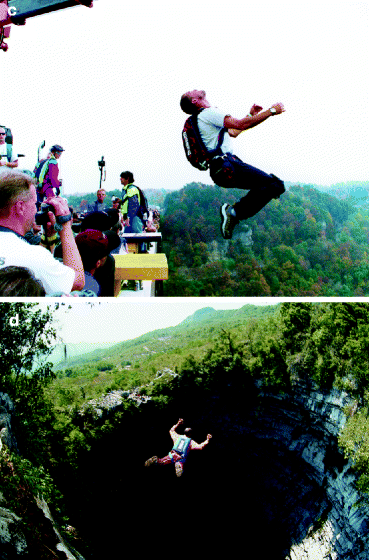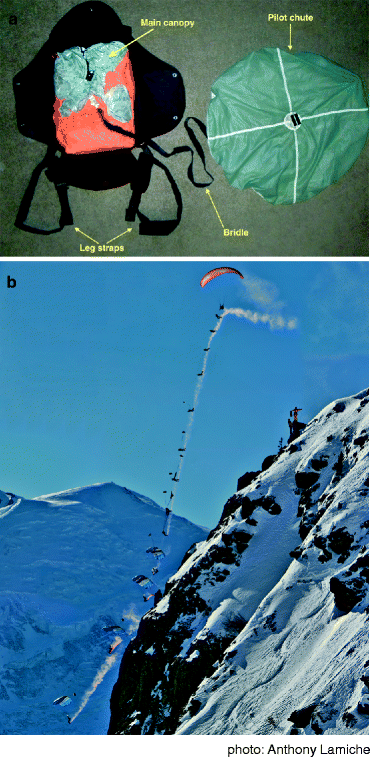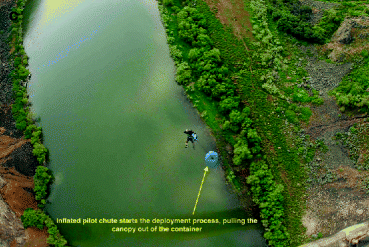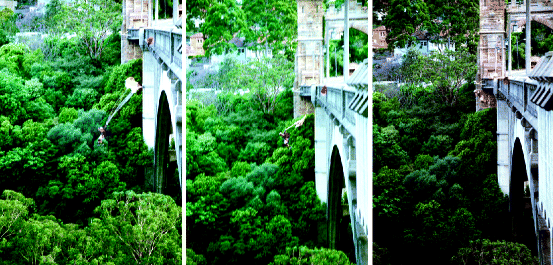
Fig. 5.1
(a) A jumper leaps off Marina Bay Sands building in Singapore. (b) A two-way jump from a high wire tower. (c) The author in a quadruple back gainer off the New River Gorge bridge, during Bridge Day, West Virginia. (d) The author jumps into the 512 meters vertical Mexican cave, Sotano the Los Golondrinas
During its early days, most BASE jumps were made using standard skydiving equipment, being conducted mainly from high cliffs. These “borrowed” skydiving parachuting systems included two parachutes (main and reserve), completely different than the established concept of a “single canopy sport” BASE jumping evolved to be. Specialized equipment and techniques, designed specifically for the unique needs of the sport, were developed later toward the 1990.
In 1997, the newly founded Cliff Jumpers Association of America (CJAA) published The CJAA Guidelines, outlining BASE standards and practices, coming from the respected and established manufacturers of the time. In parallel, legal events and competitions began to emerge; the first BASE jump courses were initiated and equipment reached safety levels never before thought possible. With this development of specific equipment, canopy packing, and jumping technique, the unacceptable injury and death rate of the early days of the sport has improved remarkably. Nevertheless, as a constantly developing sport, designated BASE parachuting systems keep on evolving, and new adjustments, modifications, and materials improve the reliability of canopy openings and jumpers safety. Many times these “new ideas” are an unfortunate result of an analyzed equipment malfunction, or suboptimal performance, following a jumping mishap or a fatality.
The Concept
In order to understand why BASE jumping is so much more dangerous than skydiving, we must appreciate first the major differences in the physics and aeronautics principles working on the BASE jumper, alongside the various aspects of the equipment used and environmental factors involved.
BASE jumps are made from much lower altitudes than skydives, often less than 500 ft above the ground, while taking place close to the object one leaps from. Skydivers use the air flow surrounding them to stabilize their position, allowing the parachute to deploy cleanly. BASE jumpers generally fall at lower speeds than skydivers (a BASE jumper rarely achieves terminal velocity), have far less aerodynamic control, and may contend with significant flying instability. As so, the attitude of the body at the moment of jumping determines the stability of flight in the first few seconds before sufficient airspeed has built up to enable aerodynamic stability. Moreover, on low BASE jumps, parachute deployment takes place during this exact early phase of the flight. If a poor “launch” leads into a tumble or is markedly asymmetric, the jumper may not be able to correct his body position, before having to deploy his chute, leading to high risk of entanglement or malfunction. Uncontrolled deployment may result in off-heading (facing the object) opening which while being irrelevant in skydiving can lead to a collision with the fixed object in BASE jumping. This “object strike” is the leading cause of serious injury and death in BASE jumping [1, 2].
By contrast, higher falling airspeeds provide jumpers with more aerodynamic control of their bodies, as well as quicker parachute deployment process, which in turn would result in more consistent on-heading opening (a canopy which inflates and flies away from the object one jumps from). This is the case with most high-cliff BASE jumps.
BASE jumps from high cliffs are found in wilderness areas, often hours of hiking away from civilization. In these jumps, a significant trauma following a jump may result in a consequent fatality, due to the time constraints of the rescue and recovery involved. Understanding winds, clouds, and possible turbulence behavior is another crucial skill, which can determine the ability to assess the feasibility of a jump. Weather changes, which can happen in a split second, may turn the whole journey into a real survival mission if proper equipment or knowledge is not available. And that is before adding the actual BASE jump into the equation.
Additionally, most BASE jumping exit points, whether urban or in nature, have very small, hazard-free areas in which to land. Good canopy skills are of real essence in this sport where one commonly needs to navigate between parking cars, electricity street cables, and poles, trees, or boulders, often at night, to a small open space where he can stall his canopy to stand.
BASE jumpers who have jumped from all four object categories may apply for a “BASE number,” which are awarded sequentially. BASE #1 was awarded to Phil Smith of Houston, Texas, in 1981. As of January 2012, over 1,600 BASE numbers have been issued [3]. However, some jumpers elect not to apply for a “BASE number” even after completing the four objects jumps, so relying on this data to assess world jumping population would be a mistake. Also, more than a few jumpers who achieved a “BASE number” have ceased jumping due to injury, fatality, or a personal (or forced) decision to retire from the sport.
Calculations within the BASE jumping community, backed up by the very few companies manufacturing BASE jumping equipment and running BASE jumping courses, estimate that less than 1,000 active jumpers are currently operating worldwide.
Legality of BASE jumping has tended to be a well-discussed issue in the media, usually following high-profile object jumps, some more successful than others. Although BASE jumping is banned at many potential jump sites, it is legal in many countries and locations worldwide and many places in the United States [2]. The main reason behind banning BASE jumps lays in liability issues which might follow an unsuccessful jump, whether in a state national park or a city skyscraper. The ability to control and order such a potential jumping site is also a major parameter, which has led to the ban of BASE jumping in many locations. Nevertheless, no specific law presently exists against BASE jumping as a sport, while the two felonies which are usually being used against unauthorized jumpers are trespassing and reckless endangerment.
These relative barriers of the sport did not stop BASE jumping from experiencing a major growth in the past decade with many new evolving subdisciplines. Some of these have pushed the boundaries of the sport so far that a “regular BASE jump” might seem almost too ordinary. These “extreme BASE jump” subdisciplines may involve complex aerobatic maneuvers, similar to the ones conducted by the pool high divers, or wingsuit flying off next to high cliffs (proximity flying). Proximity flying is one of the commonest causes of recent BASE jumping fatalities.
BASE Events and Records
In some extreme sports, the elimination of official events has been adopted. This is to try to prevent increased fatalities as athletes try to push their limits for prizes, audience, or fame. Having said that, there are some BASE jumping events which do occur and are well established and organized. Some are annual events, multi or single, while others would be high-profile one-off professional demonstrations.
The most famous of them all is the Bridge Day.
Once a year, on the third Saturday in October, permission to BASE jump has explicitly been granted at the New River Gorge Bridge (297 m high), in Fayetteville, West Virginia, USA. This annual event, celebrating first and for all the bridge “day” itself, attracts about 450 BASE jumpers and nearly 200,000 spectators. If weather permits, during the 6 h that it is legalized, there may be over 1,000 jumps. This event has a very small competition portion to it while being mainly a great celebration of the sport and an opportunity to gather jumpers from all over the world, exchange experience and information, and have fun. For many skydivers who would like to get a taste of the sport in a relatively safe manner but with proper training, this will be the only fixed object from which they ever jump. Nevertheless, fatalities did occur also from this bridge and during Bridge Day.
Real BASE competitions have been held since the early 1980s. These include landing accuracy and free fall aerobatics as the judging criteria. Recent years have seen a more “formal” competitions held at the 452-m-high Kuala Lumpur’s Petronas Towers, the 321-m-high Colorado’s “Royal Gorge Bridge” (the GoFast games), and other venues around the globe.
The evolution of wingsuit BASE flying has also led to the establishment of a formal circuit known as “The BASE Race,” where wing-suited BASE jumpers compete head to head flying off high cliffs, mainly in Europe.
In 2010, Northern Norway celebrated with a world record of 53 BASE jumpers jumping from a high fjord cliff. A 15 jumpers simultaneous building jump was recorded off China’s Jin Mao, while the tower jump record belongs to 30 jumpers simultaneously jumping off Ostankino Tower in Russia in 2004.
The Equipment Used
Parachuting Systems
A BASE jumper, or a human body for that matter, who jumps from a 150-m object has about 5.6 s of free fall to ground impact and only 10–15 s of a canopy ride if deployment takes place after 2 s following jumping. In comparison, a skydiver, after parachute deployment, may have 2–3 min of canopy ride to the ground.
On a typical BASE jump, the parachute must open at a much lower airspeed than during a skydive and much quicker while covering a shorter vertical distance as possible. Standard skydiving parachute systems are not designed to stand for these prerequisites, so BASE jumpers use specially designed parachuting systems, based on the “single canopy” concept. Although it is hard to believe and understand, a single canopy system may actually be much more reliable and safer than a parachuting system containing two separate canopies packed in the same container. Having two canopies on ones back will dictate some compromises in packing and fitting characteristics while raising the susceptibility for malfunction of the two canopies becoming entangled. Most air force fighter pilots evacuation systems comprise a single canopy only. In addition, many BASE jumps would have little time to utilize a reserve parachute, being conducted from very low altitudes or intending to deploy their chute very close to the ground (Fig. 5.2).




Fig. 5.2
Main components of a common BASE jump parachuting system are presented in (a). (b, c) In order to initiate a deployment process in a BASE jumping, the jumper must throw his pilot chute, which then pull out the main canopy out of the container
In very low jumps (below 60 m/200 ft), the parachute must open almost instantly, leaving the jumper with less than a few short seconds to release his canopy’s brakes or/and stall his canopy to land. One way to achieve this goal is to use a static line or direct bag deployments. These devices form an attachment between the bridle attached to the packed canopy and the jump platform, bypassing the normally used pilot chute. The technique would stretch out the parachute and suspension lines as the jumper falls before separating and allowing the parachute to inflate. This method is similar to the army paratrooper’s deployment system (Fig. 5.3).


Fig. 5.3
The author jumps off “Northbridge” in Sydney, Australia. This jump is only 47 m above the ground, so automatic deployment (static line) is used
Due to the major variability in objects a jumper would jump from, the parachuting system is built to be highly versatile. That is to say that in lower jump the pilot chute used would be a larger one and the canopy would be packed differently. A lower speed upon deployment would need a larger surface area of a pilot chute to generate the same pull force required to deploy the canopy of its container. Finally, most BASE jumping systems would have a “cutaway” function which will enable the jumper to release himself from the canopy, if accidentally landed on a tall tree.
Protective Gear and Assisting Equipment
In a recently published study, all BASE jumpers reported as using various protection devices with the majority wearing helmets for all jumps [4]. The other commonly worn protection devices reported to be used were ankle soft braces, knee hard pads, and spine or elbow protection in jumps with very bad landing areas. Shoulder and spine protection, shin guards, and gloves are also used commonly in BASE jumping.
In order to maintain constant communication between jumpers and their ground crew, which may be crucial to the decision-making stage prior to a jump, almost all jumpers carry two-way small radio devices with them. These are used to report or receive data regarding weather conditions in the landing area or get technical tips and recommendations from jumpers who have just completed the index jump.
Injury and Fatality Rates
Participation in BASE jumping has increased dramatically over the past decade, mainly due to the web-based video content forums, as YouTube or Vimeo. The development of small portable high-definition cameras enabled the wide release of breathtaking footage of unique jumps made by professional athletes. Nevertheless, the number of participants still remains relatively small. The sport is known to have a high dropout rate from fatality, injury, and the increased awareness of risk over time. In 2002, the total number of BASE jumpers worldwide was estimated at 700 participants [5] and the current estimate is around 1,200–1,500 participants (personal communication with BASE equipment manufacturers). Very few formal studies have been conducted on the BASE jumping population. The numbers of jumpers are relatively small, and by its very nature the sport rarely participated in groups making it hard to access these athletes and get them to respond or follow proper methodology research. The author has been a BASE jumper for many years and has facilitated access to a heterogenic group of jumpers and enabled the determination of new data on jumpers’ demographics, injuries, fatalities, and mental and physiological aspects. These research projects were initiated 5 years ago and involve also the studies of jumpers’ mental characteristics and physiology (stress hormones around a jump, etc.). We have also ran a prospective longitudinal study to assess injuries and fatalities within the sport.
Injuries in BASE Jumping
A comprehensive assessment of accidents and their sequelae in BASE jumping was published recently by the author and colleagues (Table 5.1) [4]. This study had captured 68 active jumpers, which represents around 5 % of the total world BASE jumping population with a balanced coverage of age, gender, experience, and countries of origin. The subjects conducted 19,497 jumps with an average 0.2 % severe injury rate (2 severe injuries per 1,000 jumps). Accordingly, jumpers spend a total of 15,000 jumping days leading to an injury per 384 jumping days or 2.6 significant injuries per 1,000 jumping days.
Type of injury | No. of incidents | AIS |
|---|---|---|
ICU related, multi trauma (pneumothorax, ACLS required, head injury, cervical spine) | 3 | 5 |
Head injury\concussion | 2 | 4/3 |
Fx Thoraco-Lumber-Scaral spine | 6 | 4/3 |
Fx Ribs | 5 | 4/3 |
Fx\Dx upper limb (arm, forearm, Scapula) | 4 | 4/3 |
Fx upper limbs (hand\wrist) | 4 | 3/2 |
Fx femur
Stay updated, free articles. Join our Telegram channel
Full access? Get Clinical Tree
 Get Clinical Tree app for offline access
Get Clinical Tree app for offline access

|





